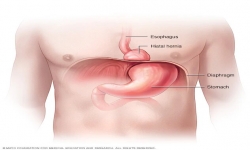
A hiatal hernia is when your stomach bulges up into your chest through an opening in your diaphragm, the muscle that separates the two areas. The opening is called the hiatus, so this condition is also called a hiatus hernia.
There are two main types of hiatal hernias: sliding and paraesophageal.
Ordinarily, your esophagus (food pipe) goes through the hiatus and attaches to your stomach. In a sliding hiatal hernia, your stomach and the lower part of your esophagus slide up into your chest through the diaphragm. Most people with hiatal hernias have this type.
A paraesophageal hernia is more dangerous. Your esophagus and stomach stay where they should be, but part of your stomach squeezes through the hiatus to sit next to your esophagus. Your stomach can become squeezed and lose its blood supply. Your doctor might call this a strangulated hernia.
Hiatal Hernia Causes
The most common cause of a hiatal hernia is an increase in pressure in the abdominal cavity. Your abdominal cavity is the space in the middle of your body that holds several organs, including the: Lower part of the esophagus and stomach. Small intestine, colon and rectum.
- Being born with a larger hiatal opening than usual
- Injury to the area
- Changes in your diaphragm as you age
- A rise in pressure in your belly, as from pregnancy, obesity, coughing, lifting something heavy, or straining on the toilet
Symptoms
- Heartburn.
- Regurgitation of food or liquids into the mouth.
- Backflow of stomach acid into the esophagus (acid reflux)
- Difficulty swallowing.
- Chest or abdominal pain.
- Feeling full soon after you eat.
- Shortness of breath.
- Vomiting of blood or passing of black stools, which may indicate gastrointestinal bleeding.
How to heal your hiatal hernia at home
According to a 2019 research reviewTrusted Source, one of the first steps in treating symptomatic hiatal hernia is addressing gastric acid secretion. Recommendations include:
- losing weight (if needed)
- decreasing food portion sizes
- eating several smaller meals throughout the day (as opposed to a few large meals)
- elevating the head of your bed by 8 inches
- avoiding meals 2 to 3 hours before bedtime or before lying down
- avoiding or limiting “trigger” foods and drink such as fried foods, fatty foods, acidic foods (citrus, tomato, vinegar), spicy foods, caffeine (coffee, chocolate), alcoholic beverages, carbonated drinks
- quitting smoking
- taking over-the-counter (OTC) medications such as antacids, such as Gaviscon (aluminum with magnesium hydroxide) or H-blockers (such as Pepcid AC or famotidine)
- avoiding tight clothing that can increase the pressure on your abdomen, such as a tight belt, control top hosiery, and body shapers
FOR MORE DETAILS: 7014505985, 7737544481, 7737544483, 9588948373, 9079916684
एक हिटाल हर्निया तब होता है जब आपका पेट आपके डायाफ्राम में एक उद्घाटन के माध्यम से आपकी छाती में उगता है, मांसपेशी जो दो क्षेत्रों को अलग करती है। उद्घाटन को अंतराल कहा जाता है, इसलिए इस स्थिति को अंतराल हर्निया भी कहा जाता है ।
हाइटल हर्निया के दो मुख्य प्रकार हैं: स्लाइडिंग और पैरासोफेगल।
आमतौर पर, आपका अन्नप्रणाली (भोजन नली) अंतराल के माध्यम से जाता है और आपके पेट से जुड़ जाता है । एक स्लाइडिंग हिटाल हर्निया में, आपका पेट और आपके अन्नप्रणाली का निचला हिस्सा डायाफ्राम के माध्यम से आपकी छाती में ऊपर की ओर स्लाइड करता है। हाइटल हर्निया वाले अधिकांश लोगों में यह प्रकार होता है।
पैराएसोफेगल हर्निया अधिक खतरनाक है। आपका अन्नप्रणाली और पेट वहीं रहता है जहां उन्हें होना चाहिए, लेकिन आपके पेट का हिस्सा आपके अन्नप्रणाली के बगल में बैठने के लिए अंतराल के माध्यम से निचोड़ता है। आपका पेट सिकुड़ सकता है और रक्त की आपूर्ति खो सकता है। आपका डॉक्टर इसे गला घोंटने वाली हर्निया कह सकता है।
हिटाल हर्निया के कारण
हिटाल हर्निया का सबसे आम कारण उदर गुहा में दबाव में वृद्धि है । आपका उदर गुहा आपके शरीर के बीच में जगह है जिसमें कई अंग होते हैं, जिनमें शामिल हैं: अन्नप्रणाली और पेट का निचला हिस्सा। छोटी आंत, बृहदान्त्र और मलाशय।
- सामान्य से अधिक बड़े अंतराल के साथ पैदा होना
- क्षेत्र में चोट
- उम्र बढ़ने के साथ आपके डायफ्राम में बदलाव
- आपके पेट में दबाव में वृद्धि, जैसे गर्भावस्था , मोटापा , खाँसी , कुछ भारी उठाना, या शौचालय पर दबाव डालना
लक्षण
- पेट में जलन।
- मुंह में भोजन या तरल पदार्थ का पुनरुत्थान।
- अन्नप्रणाली में पेट के एसिड का बैकफ्लो (एसिड भाटा)
- निगलने में कठिनाई।
- छाती या पेट में दर्द।
- खाने के तुरंत बाद पेट भरा हुआ महसूस होना।
- सांस लेने में कठिनाई।
- खून की उल्टी या काले मल का गुजरना, जो गैस्ट्रोइंटेस्टाइनल रक्तस्राव का संकेत दे सकता है।
घर पर अपने हिटाल हर्निया को कैसे ठीक करें
2019 की एक शोध समीक्षा के अनुसार , रोगसूचक हाइटल हर्निया के उपचार में पहला कदम गैस्ट्रिक एसिड स्राव को संबोधित करना है। सिफारिशों में शामिल हैं:
- वजन कम करना (यदि आवश्यक हो)
- भोजन भाग के आकार में कमी
- दिन भर में कई छोटे भोजन करना (कुछ बड़े भोजन के विपरीत)
- अपने बिस्तर के सिर को 8 इंच ऊपर उठाएं
- सोने से 2 से 3 घंटे पहले या लेटने से पहले भोजन से परहेज करें
- तले हुए खाद्य पदार्थ, वसायुक्त खाद्य पदार्थ, अम्लीय खाद्य पदार्थ (खट्टे, टमाटर, सिरका), मसालेदार भोजन, कैफीन (कॉफी, चॉकलेट), मादक पेय, कार्बोनेटेड पेय जैसे "ट्रिगर" खाद्य पदार्थों और पेय से परहेज या सीमित करना
- धूम्रपान छोड़ना
- ओवर-द-काउंटर (ओटीसी) दवाएं लेना जैसे कि एंटासिड, जैसे गेविस्कॉन (मैग्नीशियम हाइड्रॉक्साइड के साथ एल्यूमीनियम) या एच-ब्लॉकर्स (जैसे पेप्सिड एसी या फैमोटिडाइन)
- तंग कपड़ों से परहेज करें जो आपके पेट पर दबाव बढ़ा सकते हैं, जैसे कि एक तंग बेल्ट, नियंत्रण शीर्ष होजरी, और बॉडी शेपर्स


